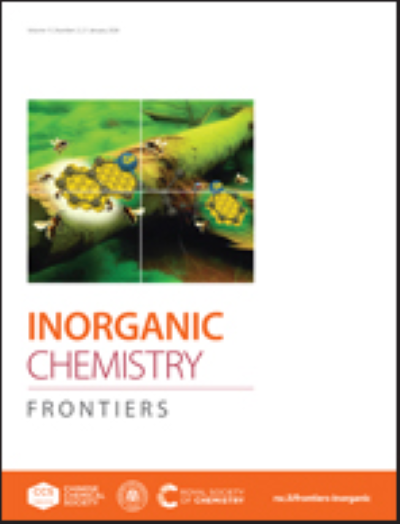Kinetics enhancement of hierarchical hollow boride microspheres for double-high aqueous Zn-based batteries
IF 6.4
1区 化学
Q1 CHEMISTRY, INORGANIC & NUCLEAR
引用次数: 0
Abstract
The unsatisfactory kinetics of the cathode electrode material are the key factor hampering the achievement of double-high performance (both high energy and high power) in aqueous Zn-based batteries. In this work, an amorphous Co-doped Ni2B hollow microsphere has been successfully constructed by a controllable etching process using a bimetallic MOF precursor. The unique hierarchical hollow structure and amorphous phase can provide more accessible active centers, abundant channels and a shortened diffusion path for enhanced redox kinetics. Therefore, the obtained CNB sample exhibits an ultra-high capacity of 2173 F g−1 (301.8 mA h g−1) at a current density of 1 A g−1 and can still maintain an initial value of 87.0% when the current density increases to 10 A g−1, achieving outstanding rate performance of CNB. Furthermore, a CNB//rGO–Zn aqueous zinc battery device is fabricated, which exhibits a high energy density of 454.7 W h kg−1 at a high power density of 0.46 kW kg−1. In addition, the CNB//rGO–Zn device can maintain 80.01% of its initial value at a current density of 6 A g−1 after 6600 cycles, revealing outstanding stability. Meanwhile, the energy storage mechanism is explored using ex situ XPS spectroscopy and ex situ TEM mapping, demonstrating that the energy storage mechanism of the CNB//rGO–Zn device involves a mixed process of the Faraday redox reaction of Co/Ni elements and the adsorption and desorption of Zn species. The CNB//rGO–Zn soft-packed device can operate an electronic thermometer for over 8 hours after several seconds of charging time, revealing its outstanding application prospect.

双层高水基锌电池中分层空心硼化物微球的动力学增强
正极材料动力学的不理想是阻碍水基锌电池实现高能量和高功率双高性能的关键因素。在本研究中,利用双金属MOF前驱体,通过可控蚀刻工艺成功构建了非晶共掺杂Ni2B空心微球。独特的分层空心结构和无定形相可以提供更容易接近的活性中心、丰富的通道和更短的扩散路径,从而增强氧化还原动力学。因此,制备的CNB样品在电流密度为1 a g−1时具有2173 F g−1 (301.8 mA h g−1)的超高容量,当电流密度增加到10 a g−1时仍能保持87.0%的初始容量,实现了优异的CNB速率性能。制备了CNB// rGO-Zn水锌电池器件,该器件在0.46 kW kg - 1的功率密度下具有454.7 W h kg - 1的高能量密度。此外,在6a g−1的电流密度下,经过6600次循环后,CNB// rGO-Zn器件仍能保持其初始值的80.01%,表现出出色的稳定性。同时,利用非原位XPS光谱和非原位TEM图谱对其储能机理进行了探索,表明CNB// rGO-Zn器件的储能机理涉及Co/Ni元素的法拉第氧化还原反应和Zn物质的吸附和解吸混合过程。CNB// rGO-Zn软包装器件在充电数秒后,可在电子温度计上工作超过8小时,显示出其出色的应用前景。
本文章由计算机程序翻译,如有差异,请以英文原文为准。
求助全文
约1分钟内获得全文
求助全文
来源期刊

Inorganic Chemistry Frontiers
CHEMISTRY, INORGANIC & NUCLEAR-
CiteScore
10.40
自引率
7.10%
发文量
587
审稿时长
1.2 months
期刊介绍:
The international, high quality journal for interdisciplinary research between inorganic chemistry and related subjects
 求助内容:
求助内容: 应助结果提醒方式:
应助结果提醒方式:


